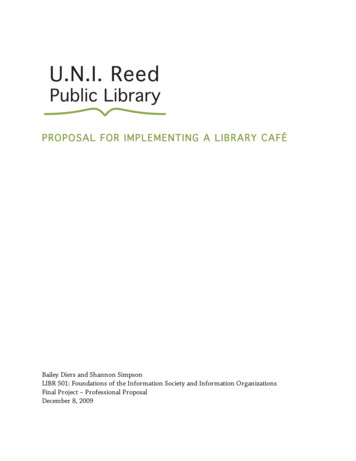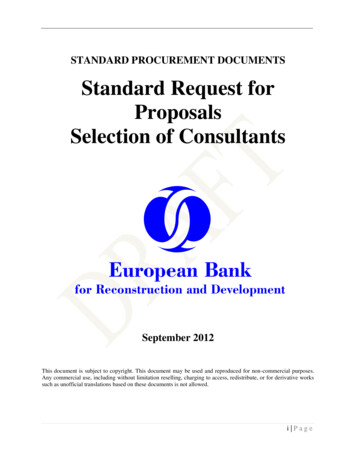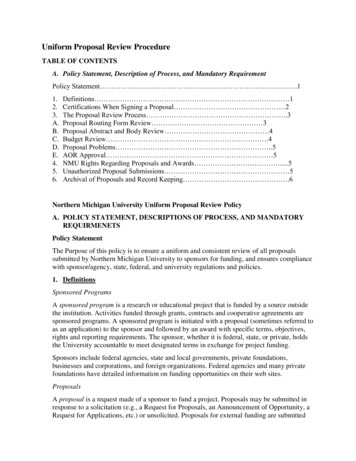
Transcription
PROPOSAL FOR IMPLEMENTING A LIBRARY CAFÉBailey Diers and Shannon SimpsonLIBR 501: Foundations of the Information Society and Information OrganizationsFinal Project – Professional ProposalDecember 8, 2009
U.N.I. Reed Public Library Proposal for Implementing a Library Café 2TABLE OF CONTENTSLETTER TO THE STAKEHOLDERS .3LITERATURE REVIEW 4GOALS& OBJECTIVES . 8POLICY STATEMENTS .10BIBLIOGRAPHY . .13
U.N.I. Reed Public Library Proposal for Implementing a Library Café 3December 8, 2009Dear U.N.I. Reed Public Library Board of Trustees,Since the approval of the three million dollar library renovation plan in June, we haveconducted numerous user surveys to gain input from our patrons as to what they would like tosee at their library when the renovations are complete. Overwhelmingly, patrons requestedsome type of café or coffee service. Our foot traffic, demographic, and space studies supportthis need and we ask for your support and approval in fulfilling this request.As you know, the U.N.I. Reed Public Library is a small, single-library district located in aresidential urban area with no surrounding cafés and few local gathering spaces. Our goals forimplementing a library café are to broaden our user base, enhance the library’s aesthetics, andfurther establish the library as a central community-gathering placeWe have conducted a literature review and have spoken with staff at several other libraries thathave recently opened cafés within their libraries. Throughout this research we have discoveredthe benefits and issues associated with implementing library cafés and have determined thetype of café and business plan best suited for U.N.I. Reed Library. We propose implementing afull-service café to be run by an independent vendor; the vendor will be determined throughour request for proposal (RFP). A minimum base rent will be decided through negotiationswith the vendor in addition to the nine percent of gross receipts that will be given to thelibrary to ensure a successful joint venture.The following proposal includes the detailed literature review, our goals and objectives, andpolicy changes associated with the addition of a café, which will need to be enacted by the boardupon approval. Please review this guide and address the Building and Grounds Committee withany questions or concerns.If the board approves this plan, we will forward all necessary information to the ConstructionCommittee, the Library Administration, and the Legal Team who will work with the architectand contractors to determine the physical design of the space and conduct the RFP process.We appreciate your support of U.N.I Reed Public Library and look forward to the changesahead.Sincerely,Bailey Diers and Shannon SimpsonCo-chairs of the Building and Grounds Committee
U.N.I. Reed Public Library Proposal for Implementing a Library Café 4LITERATURE REVIEWREASONS FOR A CAFÉIn Creating the Customer-Driven Library, Woodward (2005), discusses many facets of executinga bookstore model in the library. Chapter 15, “Food and Drink in the Library,” justifies thereasons for having a café in the library, examines in detail the main issues libraries face with acafé in their facilities, and addresses how a café augments the library experience for the user.Woodward warns that a library should always keep its mission in mind and thatimplementing a café in the library should not distract or inhibit the library’s mission.Additionally, “most successful libraries with cafés have learned that the library shouldn’t evenconsider operating it by itself” (Woodward, 2005, p.201). That said, libraries should incorporatesome control over the café’s quality and service because the café is a reflection of the library asa whole.Woodward concludes that cafés in libraries are an excellent amenity for library usersand can help attract new users to the library. A library café can support and enhance theconcept of library as a place. We envision the café at the U.N.I. Reed Public Library to be aspace that adds to the library experience, enhancing the library’s aesthetic, and facilitating asense of community within the library’s physical space. As Woodward (2005, p.195) suggests,“since ‘a place to be’ is an important function of the library, it should be an inviting, enjoyableplace it should be a place that gives pleasure to the senses.”
U.N.I. Reed Public Library Proposal for Implementing a Library Café 5Seiss’s “Is There a Coffee Shop in Your Libraries Future?” examines the benefits ofopening a coffee shop to attract users, by making the library an inviting place for patrons aswell as employees. Her conclusions address whether other libraries have been happy withintroducing coffee shops in their facilities. Harris (2007) and Harris (2003) also address howthe library can establish itself as a third place in a community—a neutral space in betweenwork life and home life—and how this strengthens the community as a whole.PLANNING AND LOGISTICS OF IMPLEMENTING A CAFÉMacLeod (1999) wrote a very helpful article, “Lattes ‘n Libraries,” discussing the different typesof decisions that need to be made and what his library, Multnomah County Library inPortland, Oregon, did when they implemented a coffee bar in their main library. MultnomahCounty Library partnered with Starbucks to install a coffee bar inside the library.Unfortunately, the coffee bar failed after six years of operation due to financial reasons. Wise(2005), in her article, “Books, Hot Coffee, and a Comfortable Chair” picks up where MacLeod’sarticle left off and evaluates why the Multnomah County Library’s coffee bar failed andcompares the Multnomah case with a successful library café.For a café to succeed, Wise concludes that the there are certain criteria that need to befollowed. We recommend abiding by these standards to give our plan the best chance ofsuccess. First and most importantly, the café needs to have its own entrance. A dedicated,outside entrance to the café serves a couple of purposes; it allows the café’s hours to extend
U.N.I. Reed Public Library Proposal for Implementing a Library Café 6beyond the library’s hours and it creates a natural barrier between the café and the librarystacks that can aid in control of food and drink in the stacks. Secondly, cafés need to be anextension of the library space, offering more then just drinks. Food products, wi-fi, live musicnights, other events, and amenities will increase foot traffic, give the café a sense of identitywithin the library, transform the café into a communal space and appeal to wider audience.Lastly, the library needs to establish a mutually vested relationship with the café vendorthrough profit sharing, coordination of events, and evaluations of café services. The potentialfor fundraising opportunities through the café can also be explored; for more information seeGerding (2006).The first step in establishing a positive relationship with the vendor is a wellcoordinated RFP process. The library administration and legal team should consult Reese’s RFPoutline for a café vendor (Welch, 2006) as well as the ALA’s “Trouble Brewing Over CoffeeVendor Selection” (2001). The successfulness of the café depends on a coherent, wellformulated, and proactive strategy.GENERAL AND ANECDOTAL INFORMATIONOur primary source for what to think about and how to begin implementing a café in a libraryis the American Library Association’s website: Libraries With Coffee Shops. This page works as agood bibliography for cafés in any type of library and includes a list of several libraries withcafes and links to their websites.
U.N.I. Reed Public Library Proposal for Implementing a Library Café 7There is an abundance of anecdotal information to draw from in planning a café in alibrary. We conducted interviews with several librarians and directors who have recently addeda café in their library (personal conversations with Corcoran, Watkins, Winkle, November2009) and also examined anecdotal evidence presented in the published literature. Welch’s(2006) “Coffee Shops in Libraries” is a very useful summary of anecdotes from various librariesfocusing on the details that are often overlooked in implementing a café. Many of these—suchas having hard floors that are easy to clean in the café itself; having tiled, durable, stainresistant carpet in the library; and ensuring that there is a prep kitchen and proper equipmentin the café—will all be conveyed to the Construction Committee to discuss with the architect,contractor and interior design team.Additionally, Pierce (1997), who caught on to the café trend early, draws on two casestudies providing information on how the culture of libraries is changing to accommodate foodand drink. He suggests that, “the traditional mindset forbidding food on library premises issimply unrealistic, and perhaps even draconian.” All of this anecdotal evidence was used tocreate the policies that are being established to accommodate changes brought on by theinclusion of a café in our library.
U.N.I. Reed Public Library Proposal for Implementing a Library Café 8GOALS&OBJECTIVESGOAL 1 : BROADEN LIBRARY USER BASEThe Library provides services to all members of the community. Currently about 42 percent ofthe city’s 50,000 people own a library card. We would like to increase our user base and attract awider audience.OBJECTIVESACTIONS Increase library use to atleast 60 percent of city’spopulation. Implement a full-service café in order to appeal to a largernumber of individuals. Expand the variety ofservices to families,students, and seniorpopulations. Provide an inviting space with seating for both groups andindividuals. Allow for flexibility in seating arrangements. Use the café as a venue for events that appeal to divergentdemographics, including open-mic nights, book clubs, authorreadings, and musical guests.GOAL 2 : ENHANCE THE LIBRARY ’ S AESTHETICThe recent three million dollar donation allows the library to expand for its ever-growing localcommunity. We need to enhance the library’s aesthetic to attract users and update our outdatedfacilities.OBJECTIVESACTIONS Update the library’sinterior for a modernizedand inviting look and feel. Build the library addition with space for a café near theentrance, accessible from both outside and inside the library. Create a warmer andmore welcomingenvironment. Select furniture and colors that complement the libraryatmosphere. Create a space large enough to be used for multi-purposes,including space rentals and library functions. Change library marketing materials to reflect the newappearance and promote the café.
U.N.I. Reed Public Library Proposal for Implementing a Library Café 9GOAL 3 : ESTABLISH THE LIBRARY AS A CENTRAL COMMUNITY GATHERING PLACEThe Library is located in a neighborhood removed from the heart of the small city. Severalretail shops are located in the vicinity, but few gathering places exist. We want to establish thelibrary as a central community gathering place.OBJECTIVESACTIONS Promote the role of thelibrary as a destination. Extend café hours beyond library hours to encourage patrons toarrive early or stay late. Form a lastingpartnership with localbusinesses. Engage in communitybuilding. Generate and distribute the RFP to begin the process ofselecting a vendor with a preference to a local vendor. Upon completion, evaluate success through user surveys andanalysis. Include customer input slips in the café and library. Invite local visual and performing artists to display artwork andperform at events to involve the community.
U.N.I. Reed Public Library Proposal for Implementing a Library Café 10LIBRARY CAFÉ POLICIESCONTENTSPolicy StatementReason for PolicyWho should know this policy?Policies & RegulationsStatement of ResponsibilityPOLICY STATEMENTThe U.N.I. Reed Public Library aims to meet the educational and recreational needs of thecommunity. The café supports this mission by providing patrons with an additional space forgathering, eating, drinking, reading, and reflection. It promotes library resources, expandslibrary services, and focuses on community building.REASON FOR POLICYFor the comfort and safety of patrons, volunteers, and staff, and the protection of libraryproperty, the following policies have been established.1 These policies will be enacted uponapproval by the Board and on completion of the café.WHO SHOULD KNOW THIS POLICY?This policy will be available to: Library staff, volunteers, patrons, the Board of Trustees, andcommunity leaders, through the library website and policy manual.1Julia L. Butterfield Memorial Library Policy Manual, 2008
U.N.I. Reed Public Library Proposal for Implementing a Library Café 11POLICIES& REGULATIONS1. SUSTAINABILITY1.1 U.N.I Reed Public Library recognizes that providing our services consumesresources that can have adverse impacts on the environment and accordingly,we have adopted a sustainability policy through which we aim to providecommunity leadership in sustainability.21.2 The library will embrace and promote sustainability within all aspects ofthe library café, including construction, financial viability, engaging with keystakeholders, embracing diversity, minimizing adverse effects on theenvironment, providing a safe and healthy work environment, and ensuring thepatrons are part of an ongoing dialog on sustainability.31.3 The café space will be sustainably constructed and maintained in such away that allows for space conversion, in the event that the café no longer fulfillsthe mission of the library or fails to meet expectations.2. FOOD2.1 Covered drinks and non-disruptive food are allowed in the library.2.2 Patrons consuming food or beverages in the library must be respectful ofother patrons and staff and avoid creating a disturbance or untidiness.4 If foodis deemed disruptive staff can ask the patron to consume the food in the café(outside food and drink will be allowed in the café per café contract).2National Library of New Zealand, 2009.3Ibid.4New Lebanon Library, undated.
U.N.I. Reed Public Library Proposal for Implementing a Library Café 122.3 Spills are the patron’s responsibility to clean.5 A spill kit will be locatedbehind the circulation desk and all reference points.3. FACILITIES3.1 It is the responsibility of patrons, library staff, and café staff to worktogether to maintain a level of cleanliness in the library.3.2 Additional signage will be posted throughout the library notifying patronsof the café and the availability of spill kits.3.3 The library will be equipped with extra trash and recycling bins toaccommodate the revised food policy. In addition to custodial staff, library andcafé staff will be responsible for periodic trash/recycling removal within theirunits.4. CAFÉ COMMITTEE4.1 A standing, long-term committee will consist of members of the librarystaff, a member of the Board of Trustees, and when necessary, a vendorrepresentative.4.2 The café committee will oversee the vendor’s adherence to the contract,perform occasional evaluations, and ensure the café’s alignment with thelibrary’s mission.STATEMENT OF RESPONSIBILITYThis policy was written by members of the U.N.I. Reed Public Library Building and GroundsCommittee and approved by Library Administration, December 2009. These policies requireapproval of the Board of Trustees.5McDermott Library, 2008
U.N.I. Reed Public Library Proposal for Implementing a Library Café 13BIBLIOGRAPHYALA. (2009). Libraries with Coffee Shops - Professionaltips. Retrieved October 26, 2009, p/Libraries with Coffee ShopsALA. (2001). Trouble Brewing over Coffee-Vendor Selection. Retrieved October 26, 2009, ing, S. (2006). Fund-raising perks of library cafes. Public Libraries, 45(6), 40-45.Harris, C. (2007). Libraries with Lattes: The New Third Place. Aplis, 20(4), 145-152.Harris, K. (2003). Your third place or mine? Public libraries and local communities. PublicLibrary Journal, 18(2), 26-29.Julia L. Butterfield Memorial Library Cold Spring, NY. (2008). Food and Beverage Policy.Retrieved October 26, 2009, from Pointe, L. M. (2006). ACRL Coffee anyone? Retrieved October 26, 2009, tions/crlnews/2006/feb/coffeeanyone.cfmMacLeod, L. (1998). Lattes 'n Libraries. The Bottom Line, 11(3), 97.McDermott Library, University of Texas at Dallas. (2008). Drink & Food Policy. RetrievedDecember 2, 2009, DrinkandFoodPolicy/detailedDaF.htmNational Library of New Zealand. (2009). Sustainability Policy. Retrieved ocuments/sustainability-policyNew Lebanon Library, New Lebanon NY. (n.d.). Patron Code of Conduct. Retrieved fromhttp://midhudson.org/department/member information/library policies.htmPierce, W. (1997). Espresso and ambiance: library cafes. - Free Online Library. The Free Library.Retrieved October 26, 2009, fromhttp://www.thefreelibrary.com/Expresso and ambiance: library cafes.-a021130011Reese, N. (1999). Cafe Service in Public Libraries. Public Libraries, 38(3), 176-78.
U.N.I. Reed Public Library Proposal for Implementing a Library Café 14Seiss, J. (2003). Is there a coffee shop in your library's future? One-Person Library, (20), 5-6.Thomas Crane Public Library, Quincy, MA. (2009). Exhibit & Display Policy. Retrieved /exhibit.shtmlWelch, J. (2006). Coffee Shops in Libraries: the summary of a Field Initiated Study. Ruby M.Sisson Memorial Library, Pagosa Springs, Colorado.Wise, M. (2005). Books, Hot Coffee, and a Comfortable Chair. Alki, 21(1), 11-12.Woodward, J. (2005). Creating the Customer-Driven Library. Chicago: American LibraryAssociation.
type of café and business plan best suited for U.N.I. Reed Library. We propose implementing a full-service café to be run by an independent vendor; the vendor will be determined through . We recommend abiding by these standards to give our plan the best chance of success. First and most importantly, the café needs to have its own entrance. .











